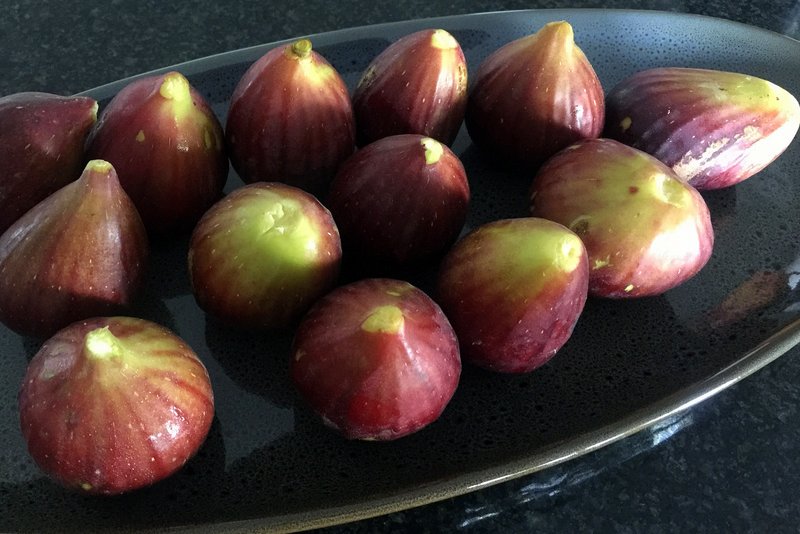Enjoy the perfect harmony of sweet figs, creamy goat cheese, prosciutto, and honey in this recipe that tastes gourmet but just takes seconds to make. You can eat ripe figs straight from the tree, but these plump drops of versatile sweet goodness are also wonderful in salads or desserts.
In Australia, figs are typically in season from late summer to early autumn, which is around February to April. However, the exact timing can vary depending on the specific region and climate conditions. It’s always best to check with local markets or growers for the most accurate information on fig seasonality in your area.
Fresh from the farm is the best way to buy your figs and my favourite spot is Wises Farm at Buderim. Check their Facebook page or look out for the sign as you drive along Wises Road at Buderim. The trays full of figs are $10 each and it’s best to have the correct money for the honour box system. Their fig season runs from December to March.
When I stayed at Bagarra near Bundaberg, Pasaline Emms used her French magic to whip an impressive tapas platter. These figs were a highlight and she has graciously shared her fresh fig recipe.
Greetings and welcome to Eat, Drink, and Be Kerry! We’re thrilled to have you join our community of food and travel enthusiasts. Your support means the world to us, and we’re grateful for the time you’ve taken to explore our content. If you’re enjoying what you find here, feel free to leave a comment, give us a “like,” share with friends, and consider subscribing for even more culinary and travel delights!

Pascaline’s Fresh Figs with Goat Cheese, Prosciutto and Honey
Although they are small, this is a filling mouthful. Purchase one or two figs for each person depending on their size and the hunger of your guests! You’ll need enough Prosciutto to wrap generously around each fig.
Ingredients
- Fresh figs
- Goats cheese
- Prosciutto
- Sprigs of Rosemary
- Honey (use an artisan honey for the best flavour)
- Olive oil
Instructions
- Preheat your oven to 180 degrees Celsius
- Cut each fig on the top with a deep cross.
- Slice the goat cheese thinly and insert into the cross on each fig.
- Roll a slice of prosciutto around each fig and fix the it to the fig with a toothpick.
- Place the figs on a baking tray and season moderately with salt and pepper.
- Sprinkle a little fresh chopped rosemary over the top.
- Drizzle each fig with honey and olive oil.
- Bake at 180 degrees Celsius, just until the cheese begins to melt.
Nutrition Information:
Yield:
6Serving Size:
1Amount Per Serving: Calories: 59Total Fat: 4gSaturated Fat: 1gTrans Fat: 0gUnsaturated Fat: 2gCholesterol: 5mgSodium: 149mgCarbohydrates: 5gFiber: 0gSugar: 4gProtein: 2g
Eatdrinkandbekerry.net offers nutritional information for recipes contained on this site. This information is provided as a courtesy and is an estimate only.

Buying your figs
I like to purchase figs straight from the farm or from roadside stalls. Always check that they are fresh and not overripe as figs are highly perishable.
Choose plump-looking figs that feel heavy for their size. They should be soft to the touch, but not mushy. Avoid figs that have split or bruised skin. You have to pick them up and give them a careful squeeze, checking for bruised or soft spots. . They should have just a little ‘give’. The colour of the skin gives a little indication, varying from green, mauve or brown: the centres can differ as widely.
Figs don’t last long and should be eaten as soon as possible after purchase. Ripe figs can be stored in the fridge for only one to two days.
How to prepare your fresh figs
Eating the skin is optional as it can sometimes be bitter. Preparation is an easy process of washing and trimming the stems. The skin peels off easily if you wish but is not necessary for this recipe. Some people choose not to eat the skin, it can sometimes be bitter, but it comes down to personal taste. Add figs to salads, pork or chicken dishes or bake them into cakes, muffins and loaves. They go equally well in both savoury and sweet dishes.
Did you know? Figs are an excellent source of dietary fibre and a good source of vitamins A, E and K.
